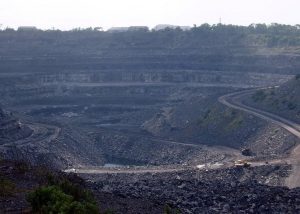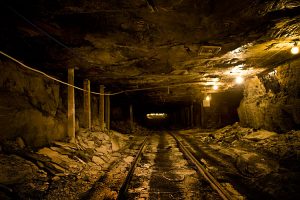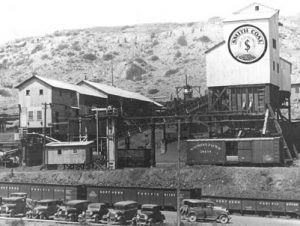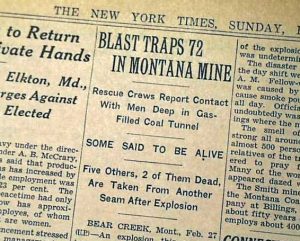
 Coal mining in modern times is mostly strip mining. Scrapers systematically strip levels of earth away, and load the ore on Unit Rigs to be taken for processing. For the most part, this is a very safe way to mine coal. Mining wasn’t always that way, and in areas where underground mining is the normal mining style, accidents are bound to happen. Coal dust can be deadly. It is a fine powdered form of coal, which is created by crushing, grinding, or pulverizing the coal. Because of the brittle nature of coal, coal dust can be created during mining, transportation, or by mechanically handling coal. Grinding coal to dust before combusting it improves the speed and efficiency of burning and makes the coal easier to handle. However, coal dust is hazardous to workers if it is suspended in air outside of the controlled environment of grinding and combustion equipment. It poses the acute hazard of forming an explosive mixture in air and the chronic hazard of causing pulmonary illness in people who inhale excessive quantities of it. Coal dust in a confined space that forms an explosive mixture, can cause a mine cave in.
Coal mining in modern times is mostly strip mining. Scrapers systematically strip levels of earth away, and load the ore on Unit Rigs to be taken for processing. For the most part, this is a very safe way to mine coal. Mining wasn’t always that way, and in areas where underground mining is the normal mining style, accidents are bound to happen. Coal dust can be deadly. It is a fine powdered form of coal, which is created by crushing, grinding, or pulverizing the coal. Because of the brittle nature of coal, coal dust can be created during mining, transportation, or by mechanically handling coal. Grinding coal to dust before combusting it improves the speed and efficiency of burning and makes the coal easier to handle. However, coal dust is hazardous to workers if it is suspended in air outside of the controlled environment of grinding and combustion equipment. It poses the acute hazard of forming an explosive mixture in air and the chronic hazard of causing pulmonary illness in people who inhale excessive quantities of it. Coal dust in a confined space that forms an explosive mixture, can cause a mine cave in.
On February 27, 1943, just such a deadly combination occurred and the resulting explosion at the Montana Coal and Iron Company mine killed 74 workers. It would become the worst mining disaster in Montana’s history, and the 43rd worst in the nation. The small towns of Washoe and Bearcreek, Montana, consisted almost entirely of mine workers and their families. Most of the men worked at Smith Mine #3 for the Montana Coal and Iron Company. Saturday morning, February 27, found 77 men working in the mine. Then, at 9:30am, a huge explosion rang out. The people of Washoe and Bearcreek heard the roar and then the long, wailing siren that followed. The exact cause of the explosion is not known, though some of the company’s miners claimed methane gas had built up in some abandoned shafts and was ignited after a cave-in. The two towns are virtually ghost towns now, with Bearcreek being the only one with people living there…a total of 79 to be exact.
Inside the mine, smoke was seen pouring from the entrance…the first indication of trouble. “There’s something wrong down here, I’m getting out,” the hoist operator called up. He and two nearby miners were the last men to leave the mine alive. Rescue crews came from as far away as Butte and Cascade county, and worked around the clock in six hour shifts to clear debris and search for possible survivors. There were none. The night of March 4, workers reached the first bodies. More followed until the toll mounted to 74. Some died as the result 
 of a violent explosion in Number 3 vein, the remainder as a result of the deadly methane gasses released by the blast. Virtually every household in Washoe and Bearcreek was touched by this tragedy. All of the bodies were removed from the mine. There is a highway plaque near the mouth of the mine, which was never reopened, and there are memorials in the cemeteries in Bearcreek and nearby Red Lodge, the county seat for Carbon County.
of a violent explosion in Number 3 vein, the remainder as a result of the deadly methane gasses released by the blast. Virtually every household in Washoe and Bearcreek was touched by this tragedy. All of the bodies were removed from the mine. There is a highway plaque near the mouth of the mine, which was never reopened, and there are memorials in the cemeteries in Bearcreek and nearby Red Lodge, the county seat for Carbon County.


Leave a Reply